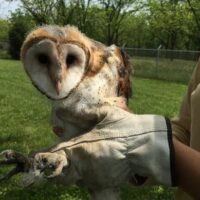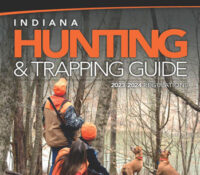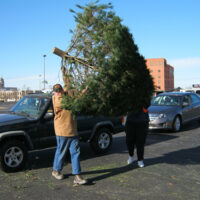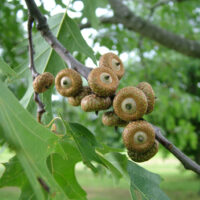 Purdue University - Extension - Forestry and Natural Resources
Purdue University - Extension - Forestry and Natural Resources
Got Nature? Blog
When do you need to discard your real Christmas tree? What options are there in disposing the tree?
Check out these tips from our Purdue experts:
Lenny Farlee, Purdue Extension Forester with Forestry and Natural Resources, in interview with the WLFI news team shares the first steps is to remove all decorations. “Several municipalities here in the area will either take the trees for mulching or composting. So if you don’t want to fool with the tree anymore, that’s a great option. You can just take it to the curb, or certain locations, and they’ll take care of it for you and it gets reused or recycled into usable material,” explains Farlee. Choosing to keep the tree in your backyard is a great wildlife friendly option. Lenny shares how important it is to remove your tree in a timely manner to avoid any fire hazards in your house. The video explains on how you can test your tree to see if it should be discarded. See video and full article for more options: Options for Getting Rid of Real Christmas Tree, wlfi.com.
John Woodmansee, Purdue Extension Educator-Agriculture Natural Resources (ANR), also shares tips in the Purdue Extension article Recycle Your Christmas Tree. If you have permission and/or have access to a private pond you can discard your tree in the pond to improve fish habitat.
Resources:
A Choose-and-Cut Pine and Fir Christmas Tree Case Study, The Education Store, Purdue Extension’s resource center
Living Christmas Trees For The Holidays and Beyond, The Education Store
Tips for First-Time Buyers of Real Christmas Trees, The Education Store
Growing Christmas Trees, The Education Store
Selecting an Indiana-Grown Christmas Tree, The Education Store
Repurposing Your Real Christmas Tree, Purdue Extension News
An Introduction to Trees of Indiana, The Education Store
Native Trees of the Midwest, The Education Store
Shrubs and Woody Vines of Indiana and the Midwest, The Education Store
ID That Tree, Playlist, Subscribe to Purdue Extension – Forestry and Natural Resources YouTube Channel
A Woodland Management Moment, Playlist, Purdue Extension – FNR YouTube Channel
Investing in Indiana Woodlands, The Education Store
Forest Improvement Handbook, The Education Store
Finding help from a professional forester, Indiana Forestry & Woodland Owners Association
District Foresters for 10 plus acres, Indiana Department of Natural Resources
Wood Products, FNR Concentration
Diana Evans, Extension & Web Communications Specialist
Purdue University Department of Forestry and Natural Resources
In this edition of ID That Tree, we’re going to introduce you to another member of the oak family found in Indiana, and that’s northern pin oak. You can find it in the northern part of Indiana on dry and sandy soils. It’s a member of the red and black oak group, so it has bristle tips on the ends of the lobes of the leaves. The twigs can be found anywhere from medium to dark grey, and the buds are very dark and sharply pointed.
If you have any questions regarding wildlife, trees, forest management, wood products, natural resource planning or other natural resource topics, feel free to contact us by using our Ask an Expert web page.
Resources:
ID That Tree, Playlist, Purdue Extension – Forestry and Natural Resources (FNR) YouTube Channel (Invasive White Mulberry, Siberian Elm, Tree of Heaven)
Invasive Species Playlist, Playlist, Purdue Extension – FNR YouTube Channel (Asian Bush Honeysuckle, Burning Bush, Callery Pear, Multiflora rose)
A Woodland Management Moment, Playlist, Purdue Extension – FNR YouTube Channel (Against Invasives, Garlic Mustard, Autumn Olive)
Woodland Stewardship for Landowners, Playlist, Purdue Extension – FNR YouTube Channel (Common Buckthorn, Japanese Barberry)
How long do seeds of the invasive tree, Ailanthus altissima remain viable? (Invasive Tree of Heaven), USDA Forest Service
Indiana Department of Natural Resources: Invasive Species
Indiana Invasive Species Council
Cooperative Invasive Species Management Area (CISMA)
Report Invasive, Purdue Extension
Aquatic Invasive Species, Illinois-Indiana Sea Grant (IISG)
Episode 11 – Exploring the challenges of Invasive Species, Habitat University-Natural Resource University
What are invasive species and why should I care?, Got Nature? Blog, Purdue Extension – FNR
Shrubs and Woody Vines of Indiana and the Midwest, The Education Store, Purdue Extension Resource Center
Native Trees of the Midwest, The Education Store
Investing in Indiana Woodlands, The Education Store
Professional Forester, Indiana Forestry Woodland Owners Association
District Forester 10+acres of woodlands, Indiana Department of Natural Resources
Forest Improvement Handbook, The Education Store
Lenny Farlee, Extension Forester
Hardwood Tree Improvement and Regeneration Center
Purdue Department of Forestry & Natural Resources
Wild Bulletin, Indiana Department of Natural Resources (DNR) Fish and Wildlife: Did you know that wild game shot with lead ammunition can sometimes contain lead fragments all the way to the dinner table? Adopting different shot placement and butchering techniques can help alleviate the problem.
When shooting: Avoid shooting animals in heavily boned areas, such as the front shoulders, as this is more likely to cause bullet fragmentation. Instead, shoot animals in softer tissue, such as around the heart and lungs, to decrease fragmentation.
When butchering: Carefully observe the wound channel in the animal and generously trim away any meat that shows bullet trauma. This will help keep fragments out of your finished meat product. Properly dispose of your trimmed meat by sending it to the local landfill or burying it on private property.
Looking for another way for you and your family to avoid ingesting lead fragments? Talk to your local retailer about finding a nontoxic ammunition that’s right for you.
To learn more please visit DNR: Effects of lead on wildlife.
Resources:
Hunting Guide for 2023-2024, Indiana Department of Natural Resources
How to Score Your White-tailed Deer, video, The Education Store, Purdue Extension Resource Center
White-Tailed Deer Post Harvest Collection, video, The Education Store
Age Determination in White-tailed Deer, video, The Education Store
How to Build a Plastic Mesh Deer Exclusion Fence, The Education Store
Managing Your Woods for White-Tailed Deer, The Education Store
Bovine Tuberculosis in Wild White-tailed Deer, The Education Store
Help With Wild Turkey Populations, Video, Purdue Extension – Forestry and Natural Resources YouTube Channel
Turkey Brood Reporting, Indiana Department of Natural Resources (IDNR)
Wild Turkey, Indiana Department of Natural Resources (IDNR)
Wild Turkey Hunting Biology and Management, Indian Department of Natural Resources (IDNR)
Subscribe to Purdue Extension-Forestry & Natural Resources YouTube Channel, Wildlife Playlist
Indiana Department of Natural Resources
In this edition of ID That Tree, we’re going to introduce you to a native Indiana species, and that’s sourwood. It’s much more common in the Appalachian mountain range, but can be found on Indiana’s southern boundary across the Ohio River. Sourwood gets its name from its sour/bitter flavor when you taste it. It has alternate leave arrangement, simple leaves, and very finely serrated margins. It can also put on a great fall color.
If you have any questions regarding wildlife, trees, forest management, wood products, natural resource planning or other natural resource topics, feel free to contact us by using our Ask an Expert web page.
Resources:
ID That Tree, Playlist, Purdue Extension – Forestry and Natural Resources (FNR) YouTube Channel (Invasive White Mulberry, Siberian Elm, Tree of Heaven)
Invasive Species Playlist, Playlist, Purdue Extension – FNR YouTube Channel (Asian Bush Honeysuckle, Burning Bush, Callery Pear, Multiflora rose)
A Woodland Management Moment, Playlist, Purdue Extension – FNR YouTube Channel (Against Invasives, Garlic Mustard, Autumn Olive)
Woodland Stewardship for Landowners, Playlist, Purdue Extension – FNR YouTube Channel (Common Buckthorn, Japanese Barberry)
How long do seeds of the invasive tree, Ailanthus altissima remain viable? (Invasive Tree of Heaven), USDA Forest Service
Indiana Department of Natural Resources: Invasive Species
Indiana Invasive Species Council
Cooperative Invasive Species Management Area (CISMA)
Report Invasive, Purdue Extension
Aquatic Invasive Species, Illinois-Indiana Sea Grant (IISG)
Episode 11 – Exploring the challenges of Invasive Species, Habitat University-Natural Resource University
What are invasive species and why should I care?, Got Nature? Blog, Purdue Extension – FNR
Shrubs and Woody Vines of Indiana and the Midwest, The Education Store, Purdue Extension Resource Center
Native Trees of the Midwest, The Education Store
Investing in Indiana Woodlands, The Education Store
Professional Forester, Indiana Forestry Woodland Owners Association
District Forester 10+acres of woodlands, Indiana Department of Natural Resources
Forest Improvement Handbook, The Education Store
Lenny Farlee, Extension Forester
Hardwood Tree Improvement and Regeneration Center
Purdue Department of Forestry & Natural Resources
Wild Bulletin, Indiana Department of Natural Resources (DNR) Fish and Wildlife: In 2023, we saw wildlife wins for many rare and endangered species. We found a very young hellbender salamander in the Blue River and increased public awareness and interest in bat conservation. We discovered the banded pygmy sunfish at Twin Swamps Nature Preserve and doubled the number of active barn owl nests from five years ago.
These wildlife wins would not have been possible without those who support the Nongame Wildlife Fund. To all of you who help care for Indiana’s rare and endangered wildlife, thank you!
If you’d like to make a positive impact on Indiana’s wildlife, consider getting involved today. Subscribe to the Indiana DNR Division of Fish & Wildlife Newsletter, IN Fish & Wildlife Instagram, and IN Fish & Wildlife Facebook to stay up to date with the IN DNR-Division of Fish & Wildlife’s latest wildlife wins. Make a volunteer profile and learn more about how to become a DNR volunteer, or make a donation to the Nongame Wildlife Fund. For every $50 given to the Nongame Wildlife Fund, an additional $43 is unlocked in federal funding, making every dollar you donate go even further for Indiana’s wildlife.
To learn more please visit DNR: Nongame and Endangered Wildlife.
Resources:
Researchers Discover Young Hellbender in Blue River, Purdue Forestry and Natural Resources News & Stories
Help the Hellbender, North America’s Giant Salamander, The Education Store
Help the Hellbender website
Help the Hellbender Facebook page
Barn Owl, Indiana Department of Natural Resources
Bats in Indiana, Indiana Department of Natural Resources (IN DNR)
Bat Houses, Bat Conservation International
Creating a Wildlife Habitat Management Plan for Landowners, The Education Store, Purdue Extension’s resource center
Ask an Expert: Turtles and Snakes, video
Ask an Expert: Managing Your Property for Fish and Wildlife, video
A Template for Your Wildlife Habitat Management Plan, publication
Frost Seeding to Establish Wildlife Food Plots and Native Grass and Forb Plantings, video
Connecting Youth to Wildlife Webinar
Developing a Wildlife Habitat Management Plan, The Education Store
Indiana Department of Natural Resources
In this edition of ID That Tree, we’re going to introduce you to two species found in Indiana. One of them is a native called blackhaw, and the other an invasive called burning bush. Blackhaw has opposite simple leaves, very finely toothed margins, and elongated buds that have a grey haze to them. It also has a striking fall color. Burning bush on the other hand is an invasive spread by seeding itself through birds and other wildlife. It also has opposite leaf arrangement but much smaller leaves that are a bit more elongated.
If you have any questions regarding wildlife, trees, forest management, wood products, natural resource planning or other natural resource topics, feel free to contact us by using our Ask an Expert web page.
Resources:
ID That Tree, Playlist, Purdue Extension – Forestry and Natural Resources (FNR) YouTube Channel (Invasive White Mulberry, Siberian Elm, Tree of Heaven)
Invasive Species Playlist, Playlist, Purdue Extension – FNR YouTube Channel (Asian Bush Honeysuckle, Burning Bush, Callery Pear, Multiflora rose)
A Woodland Management Moment, Playlist, Purdue Extension – FNR YouTube Channel (Against Invasives, Garlic Mustard, Autumn Olive)
Woodland Stewardship for Landowners, Playlist, Purdue Extension – FNR YouTube Channel (Common Buckthorn, Japanese Barberry)
Invasive Plant Series: Winged Burning Bush, Got Nature? Blog, Purdue Extension – FNR
Invasive Plant Series: Winged Burning Bush, The Education Store
How long do seeds of the invasive tree, Ailanthus altissima remain viable? (Invasive Tree of Heaven), USDA Forest Service
Indiana Department of Natural Resources: Invasive Species
Indiana Invasive Species Council
Cooperative Invasive Species Management Area (CISMA)
Report Invasive, Purdue Extension
Aquatic Invasive Species, Illinois-Indiana Sea Grant (IISG)
Episode 11 – Exploring the challenges of Invasive Species, Habitat University-Natural Resource University
What are invasive species and why should I care?, Got Nature? Blog, Purdue Extension – FNR
Shrubs and Woody Vines of Indiana and the Midwest, The Education Store, Purdue Extension Resource Center
Native Trees of the Midwest, The Education Store
Investing in Indiana Woodlands, The Education Store
Professional Forester, Indiana Forestry Woodland Owners Association
District Forester 10+acres of woodlands, Indiana Department of Natural Resources
Forest Improvement Handbook, The Education Store
Lenny Farlee, Extension Forester
Hardwood Tree Improvement and Regeneration Center
Purdue Department of Forestry & Natural Resources
MyDNR, Indiana’s Outdoor Newsletter: The latest Hunting Guide for 2023-2024 is available. The Division of Fish & Wildlife is excited to show off the many methods and precautions needed to be successful during hunting season. Here are some current in season game you can hunt.
Hunting seasons in December
Deer Muzzleloader: Dec. 9–24
Wild Turkey Fall Archery: Dec. 2, 2023–Jan. 7, 2024
Pheasant (Cock only): Closes Dec. 15
Dove: Dec. 16, 2023–Jan. 3, 2024
Crow: Dec. 13, 2023–March 1, 2024
Snipe: Closes Dec. 16
Quail (north of Interstate 74): Closes Dec. 15
Quail (south of Interstate 74): Closes Jan. 10, 2024
Ducks (North Zone): Closes Dec. 17, reopens Dec. 26, 2023–Jan. 3. 2024
Ducks (South Zone): Dec. 2, 2023–Jan. 28, 2024
For more information on hunting dates please our Indiana 2023-2024 Hunting & Trapping Seasons.
For questions on licenses and fees view Licenses & Permits, Indiana Department of Natural Resources
To subscribe to the newsletter visit MyDNR Email Newsletter.
Explore the outdoors with Indiana Department of Natural Resources in their 24 state parks, Indiana State Parks and Lakes.
Resources:
Hunting Guide for 2023-2024, Indiana Department of Natural Resources
How to Score Your White-tailed Deer, video, The Education Store, Purdue Extension Resource Center
White-Tailed Deer Post Harvest Collection, video, The Education Store
Age Determination in White-tailed Deer, video, The Education Store
How to Build a Plastic Mesh Deer Exclusion Fence, The Education Store
Managing Your Woods for White-Tailed Deer, The Education Store
Bovine Tuberculosis in Wild White-tailed Deer, The Education Store
Help With Wild Turkey Populations, Video, Purdue Extension – Forestry and Natural Resources YouTube Channel
Turkey Brood Reporting, Indiana Department of Natural Resources (IDNR)
Wild Turkey, Indiana Department of Natural Resources (IDNR)
Wild Turkey Hunting Biology and Management, Indian Department of Natural Resources (IDNR)
Subscribe to Purdue Extension-Forestry & Natural Resources YouTube Channel, Wildlife Playlist
Indiana Department of Natural Resources, Department of Fish & Wildlife
In this edition of ID That Tree, we’re going to introduce you to a native Indiana species, and that’s grey birch. It can be found in the northern part of Indiana near Lake Michigan. It can be defined by its long and pointed triangular shape, and it toothed margins on the edges of the leaf. It has very limber twigs and the leaves are arranged alternately. Also the fruiting flower structure can be identified as a catkin.
If you have any questions regarding wildlife, trees, forest management, wood products, natural resource planning or other natural resource topics, feel free to contact us by using our Ask an Expert web page.
Resources:
ID That Tree, Playlist, Purdue Extension – Forestry and Natural Resources (FNR) YouTube Channel (Invasive White Mulberry, Siberian Elm, Tree of Heaven)
Invasive Species Playlist, Playlist, Purdue Extension – FNR YouTube Channel (Asian Bush Honeysuckle, Burning Bush, Callery Pear, Multiflora rose)
A Woodland Management Moment, Playlist, Purdue Extension – FNR YouTube Channel (Against Invasives, Garlic Mustard, Autumn Olive)
Woodland Stewardship for Landowners, Playlist, Purdue Extension – FNR YouTube Channel (Common Buckthorn, Japanese Barberry)
How long do seeds of the invasive tree, Ailanthus altissima remain viable? (Invasive Tree of Heaven), USDA Forest Service
Indiana Department of Natural Resources: Invasive Species
Indiana Invasive Species Council
Cooperative Invasive Species Management Area (CISMA)
Report Invasive, Purdue Extension
Aquatic Invasive Species, Illinois-Indiana Sea Grant (IISG)
Episode 11 – Exploring the challenges of Invasive Species, Habitat University-Natural Resource University
What are invasive species and why should I care?, Got Nature? Blog, Purdue Extension – FNR
Shrubs and Woody Vines of Indiana and the Midwest, The Education Store, Purdue Extension Resource Center
Native Trees of the Midwest, The Education Store
Investing in Indiana Woodlands, The Education Store
Forest Improvement Handbook, The Education Store
Lenny Farlee, Extension Forester
Hardwood Tree Improvement and Regeneration Center
Purdue Department of Forestry & Natural Resources
 A real Christmas tree is an important part of a holiday celebration for many Hoosier households. Consumers have several choices for purchasing a real tree, including pre-cut trees at retail outlets or seasonal sales locations, choose-and-cut trees at Christmas tree farms, or even live trees that can be replanted after the holidays. Purdue Extension offers two publications that can help you select and care for your tree: Tips for First-Time Buyers of Christmas Trees provides advice and direction on how to set up and care for your tree to improve safety and enjoyment. Selecting an Indiana-Grown Christmas Tree provides details on the characteristics of different species of real Christmas trees available in Indiana, as well as care instructions for cut and live Christmas trees.
A real Christmas tree is an important part of a holiday celebration for many Hoosier households. Consumers have several choices for purchasing a real tree, including pre-cut trees at retail outlets or seasonal sales locations, choose-and-cut trees at Christmas tree farms, or even live trees that can be replanted after the holidays. Purdue Extension offers two publications that can help you select and care for your tree: Tips for First-Time Buyers of Christmas Trees provides advice and direction on how to set up and care for your tree to improve safety and enjoyment. Selecting an Indiana-Grown Christmas Tree provides details on the characteristics of different species of real Christmas trees available in Indiana, as well as care instructions for cut and live Christmas trees.
Pre-cut real Christmas trees are available at many retail outlets like garden centers, supermarkets, or seasonal sales locations. If you are looking for local choose-and-cut Christmas tree farms you can consult local media and advertising outlets or the Indiana Christmas Tree Growers Association. Some garden centers and Christmas tree farms may also offer live trees for sale.
If you are considering growing your own Christmas trees for personal use or sale, the Extension publications Growing Christmas Trees and A Choose-and-Cut Pine and Fir Christmas Tree Case Study outline economic and management considerations for growing Christmas trees.
Check out the recorded Facebook LIVE for Ask an Expert: Holidays in the Woods as the experts answer questions regarding Christmas trees along with wildlife you may see while you walk in the woods this winter.
Resources:
A Choose-and-Cut Pine and Fir Christmas Tree Case Study, The Education Store, Purdue Extension’s resource center
Living Christmas Trees For The Holidays and Beyond, The Education Store
Tips for First-Time Buyers of Real Christmas Trees, The Education Store
Growing Christmas Trees, The Education Store
Selecting an Indiana-Grown Christmas Tree, The Education Store
Forest/Timber Playlist, subscribe to Purdue Extension – Forestry and Natural Resources YouTube Channel
Lenny Farlee, Sustaining Hardwood Extension Specialist
Hardwood Tree Improvement and Regeneration Center
Purdue Department of Forestry & Natural Resources
Forest Management for the Private Woodland Owner is a Purdue University short course providing knowledge and resources to help landowners make informed decisions in the care and management of their forests.
Topics covered include tree identification, forest history and biology, forest management planning, forest management practices, considerations for selling timber, forest investment and taxation, wildlife habitat management, and resources and assistance for private woodland owners.
In addition to previously announced courses (virtual and in-person near Wabash, Indiana), a third offering will be available near the Southern Indiana Purdue Agricultural Center (SIPAC) in Dubois, Indiana. (11371 E Purdue Farm Rd., Dubois, IN 47527)
This workshop, led by Purdue Extension forester Ron Rathfon, will be taught from Feb. 5 to March 25, 2024, at SIPAC on the north side of Patoka Lake near the dam entrance.
The course will include eight weekly meetings on Mondays from 6 p.m. to 9 p.m. ET, as well as two Saturday morning field tours, running from 9 a.m. to noon.
Class size is limited to 40 registrants on a first-come, first served basis. Register with easy printable, mail-in pdf, Forest Management of the Private Woodland Owner Course.
Registration cost is $50 per person and includes: in-person time with forestry specialists, all course materials, a thumb drive of all publications, a tree measuring stick and snacks. Guest registration (in addition to initial registration) is $30 and includes all learning sessions and handouts at the sessions.
Contact Ron Rathfon at ronr@purdue.edu or 812-678-5049 with any questions.
The Southern Indiana Purdue Ag Center is a 1,331 acre working farm and research and education facility designed to address practical farm and natural resource management problems providing practical solutions and education and training opportunities for farmers, landowners, foresters, and other natural resource professionals.
Purdue acquired the first piece of the property which became SIPAC in 1953 and additional forest acres were added in 1966 and 1967. Purdue FNR faculty and staff have taken an active role in management of the forest at SIPAC since 1953. The facility also has housed an extension forester since the mid-1960s.
Rathfon has served as a Purdue extension forester since 1992. He has taught the Forest Management for the Woodland Owners course since 1993.
Resources:
Forest Management for the Private Woodland Owner Course Program Impacts, Purdue Extension-Forestry and Natural Resources (FNR)
Forest Management for the Private Woodland Owner Course – Wabash County, Purdue Extension-FNR Events
Forestry Management for the Private Woodland Owner Course – SIPAC, Purdue Extension-FNR Events
Virtual Forest Management for the Private Woodland Owner Course, Purdue Extension-FNR Events
Forestry Management for the Private Woodland Owner Course – Jackson County, Purdue Extension-FNR Events
Cost Assistance for Landowners Planning Conservation Practices, Purdue Extension-FNR Got Nature? Blog
Woodland Stewardship for Landowners: EQUP, video, Purdue Extension-Forestry and Natural Resources (FNR) YouTube Channel
Woodland Stewardship for Landowners YouTube Playlist, Purdue Extension – FNR
Woodland Management Moment: Invasive Species Control Process, Purdue Extension – FNR Video
Woodland Management Moment YouTube Playlist, Purdue Extension – FNR
Invasive Species YouTube Playlist, Purdue Extension – FNR
What are invasive species and why should I care?, Got Nature? Blog, Purdue Extension – Forestry and Natural Resources
Report Invasive Species, Purdue Invasive Species
The GLEDN Phone App – Great Lakes Early Detection Network
EDDMaps – Early Detection and Distribution Mapping System
Hardwood Ecosystem Experiment: Uneven-aged Management, Purdue Extension – FNR Video
Finding help from a professional forester, Indiana Forestry & Woodland Owners Association
Forest Improvement Handbook, The Education Store, Purdue Extension resource center
Ron Rathfon, Regional Extension Forester, Southern Indiana Purdue Agriculture Center (SIPAC)
Purdue Forestry and Natural Resources
Recent Posts
- Are you seeing nests of our state endangered swan? – Wild Bulletin
Posted: April 9, 2024 in Alert, Forestry, How To, Wildlife - 2024-25 Fishing Guide now available – Wild Bulletin
Posted: April 4, 2024 in Alert, Aquaculture/Fish, Aquatic/Aquaculture Resources, How To, Ponds, Wildlife - Help Research Chronic Wasting Disease – Wild Bulletin
Posted: April 3, 2024 in Disease, Forestry, How To, Safety, Wildlife, Woodlands - Indiana Reptiles and Amphibians – IFWOA Webinar
Posted: April 1, 2024 in Forestry, How To, Webinar, Wildlife, Woodlands - Birding through the Seasons – IFWOA Webinar
Posted: in Forestry, How To, Webinar, Wildlife, Woodlands - Renew Your Indiana Annual Fishing, Hunting, and Trapping License, MyDNR
Posted: March 28, 2024 in Aquaculture/Fish, Aquatic/Aquaculture Resources, How To, Wildlife - ID That Tree: Canada Yew
Posted: in Forestry, Forests and Street Trees, How To, Plants, Wildlife, Woodlands - How to Interact with Young Wildlife This Spring, MyDNR
Posted: in Forestry, How To, Safety, Wildlife, Woodlands - Spring Tree Preparations
Posted: March 26, 2024 in Forestry, Forests and Street Trees, How To, Urban Forestry, Wildlife, Woodlands - Tracking the Bloom
Posted: in Forestry, Forests and Street Trees, How To, Plants, Wildlife, Woodlands
Archives
Categories
- Alert
- Aquaculture/Fish
- Aquatic/Aquaculture Resources
- Ask the Expert
- Christmas Trees
- Community Development
- Disease
- Drought
- Forestry
- Forests and Street Trees
- Gardening
- Got Nature for Kids
- Great Lakes
- How To
- Invasive Animal Species
- Invasive Insects
- Invasive Plant Species
- Land Use
- Natural Resource Planning
- Nature of Teaching
- Plants
- Podcasts
- Ponds
- Publication
- Safety
- Timber Marketing
- Uncategorized
- Urban Forestry
- Webinar
- Wildlife
- Wood Products/Manufacturing
- Woodland Management Moment
- Woodlands


